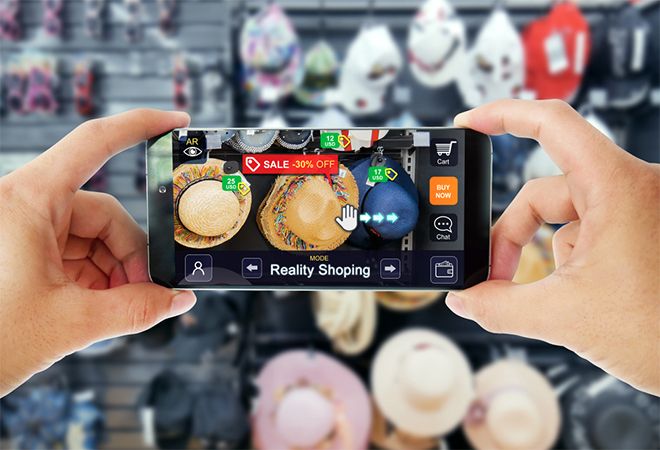If your idea of Augmented Reality (AR) is confined to Pokemon Go, it’s time you had a re-education. Whilst AR is yet to become ubiquitous in the retail space, more and more retailers are turning to the technology to give their stores and brands the edge.
Retailers are always searching for new ways to display their products, whether that be instore, online or on a mobile. For retailers looking for consumer engagement, AR provides a very appealing way for consumers to interact with merchandise.Whether that be at a brick and mortar store, an e-tailer or on an app on a mobile device.
It’s a trend that has been picked up by big and small retailers. Ray-Ban’s Virtual Mirror is a great example of augmented reality online. It allows shoppers to virtually try on and sample the brand’s famous glasses directly from their computer, without ever leaving the comfort of home.
While it would be easy to dismiss AR as a passing trend, recent statistics released by Paypal found that a third of Australia’s small to medium retailers who operate online, plan to utilise some kind of AR experience for their customers.
Local bag and tech accessory company STM Goods has already jumped on board the AR train. Ethan Nyholm, founder and owner of the Sydney-based brand tells Kochie’s Business Builders they decided to utilise AR to enable customers to virtually ‘try on’ their bags.
“Backpacks have traditionally been one of the toughest products to showcase in store, unless a trained salesperson is there to demonstrate the special aspects of the merchandise, which typically is not the case,” Nyholm says.
“We noticed that commerce was increasingly being conducted through mobile phones, and saw the opportunity to develop an AR app that would enable customers to virtually try on our products and demonstrate the unique selling points and features. We hope that the AR will create an experience that will allow customers to interact with the product in ways that they have never been able to before.”
Nyholm says customer response to the brand’s AR experience has been overwhelmingly positive.

“Since integrating AR, we have seen an uplift in both customer engagement and sales, and we attribute this to giving shoppers the opportunity to explore our products in full, and gain an understanding of the thought that goes into each design. The feedback from our customers has been that they like being able to get a feel for our products, both inside and out, before purchasing,” he says.
Interestingly Nyholm says customers will often interact with the app before moving on to purchase in a brick and mortar store.
“This is exactly the customer journey that we are hoping our AR app will facilitate – it signals to us that there is a real desire from customers for AR technology within the retail space.”
Nyholm suggests using AR within a retail environment leverages today’s technology to go beyond what’s long been the expected in store.
“As well as helping customers explore products before buying, AR has the potential to help retail employees in store gain a deeper understanding of the products, which can in turn better assist the sale process,” he says.
Nyholm is not alone in this belief. Consumers are clamouring for AR solutions. According to Paypal’s MCommerce trends report the ability to virtually try before you buy answers a key consumer concern as mobile shoppers still struggle with being unable to see what products will look like in their homes or in use; or whether fashion items will fit or suit them.
88 per cent of those surveyed by Paypal said they were concerned about which size will fit and size variation between brands and 82 per cent were concerned that even if the size was right, they didn’t know how the item would look on them or in their home.

Sephora lets you try out looks, colour match and more
But are retailers taking the hint? The answer is ‘yes’! In the past few months, more big businesses have seen the advantages of utilising AR. Cosmetic giant L’Oreal recently acquired startup, Modi Face, whose AR app lets consumers try out different make-up looks, while Specsavers is also utilising AR to allow clients to model their glasses pre-purchase.
It’s brave new world.
And the advances in retail tech don’t stop there.
Intel’s RFID (radio frequency identification) tech and its overhead readers are already making changes to the way stores track their stock.
Iconic fashion label G-Star RAW is using RFID to track store inventory in real time.
It’s helped G-Star increase its “stock accuracy” level to nearly 100 per cent from about 75 per cent and helped it identify why an item may be consistently bypassed for purchase, said Patrick Den Haan, G-Star RAW’s project manager.
VR is also being considered beyond the gimmick factor as a practical tool to assist retailers and businesses to boost the customer experience and even recreate physical stores in a virtual environment.
Major retailers have begun to unlock the potential of VR in e-commerce. In recent years, much of the VR experimentation in retail was centred on in-store experience, but the focus now appears to be shifting to e-commerce.
At the recent Mobile World Congress, Chinese retail giant, Alibaba announced it would be investing heavily into VR by joining forces with VR specialist iStaging. The platform will bring VR capabilities to Tmall allowing sellers to recreate digital versions of their physical stores. The move follows on from the company’s 2016 launch of Buy+ which let’s customers browse items in a virtual shopping mall.
It seems VR, AR and RFID are here to stay and continuing advances with this tech are transforming the retail space. Smart retailers will take advantage of the new tech to help them grow their business.









































Trending
Weekly business news and insights, delivered to your inbox.